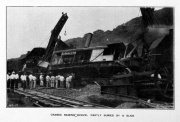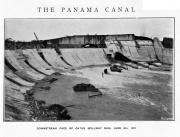The Panama Canal is a 77.1 kilometre (48 mile) ship canal in Panama that connects the Atlantic Ocean (via the Caribbean Sea) to the Pacific Ocean. The canal cuts across the Isthmus of Panama and is a key conduit for international maritime trade. There are locks at each end to lift ships up to Gatun Lake, an artificial lake created to reduce the amount of excavation work required for the canal, 26 metres (85 ft) above sea level. The current locks are 33.5 metres (110 ft) wide. A third, wider lane of locks opened for commercial traffic in 2016.[1]
1881 Construction of the canal was originally a French project. It was promoted by the highly charimastic Ferdinand de Lesseps, who was credited with construction of the successful and highly profitable Suez Canal. The Compagnie Universelle du Canal Interocéanique de Panama was established to undertake the project.
However, De Lessep's vision of a sea-level canal was ill-conceived. He visited the site only a few times, during the dry season, and failed to address the problem posed by the Chagres River, which became a raging torrent, rising up to 10 m (35 ft) in the wet season. The dense and inhospitable jungle was a formidable barrier. Mosquito-borne tropical diseases, primarily yellow fever, and malaria, along with other diseases would kill thousands of workers and put many more out of action. The death rate reached more than 200 per month. In many cases incoming workers succumbed and died within days of arrival. Conditions were downplayed in France, but the high mortality rate made it difficult to maintain an experienced workforce. After carrying out extensive excavation, the unreality of having a sea-level canal became clearly apparent, and plans were hastily revised. As an example of technical problems, the 9-mile cut through the mountain at Culebra had to be progressively widened to reduce the angles of the slopes in order to minimize landslides into the canal.
In early 1883 Jules Isidore Dingler was appointed as the Director of Engineering on site. He was dynamic and effective, but by August 1885 he was close to physical and mental collapse, and he left for France. His wife, son and daughter had died of yellow fever. He was replaced by Maurice Hutin, who quit after a few weeks. He was replaced by Philippe Bunau-Varilla, aged just 27.
The health problems, technical challenges, and escalating costs were downplayed in France. Misleading statements were made in order to obtain further subscriptions from the public, but eventually the money ran out and the company went bankrupt in 1889. An estimated 22,000 men died from disease and accidents, and the hundreds of thousands of investors lost all their savings. In the ensuing scandal some leading players were prosecuted, including Gustave Eiffel. De Lesseps and his son Charles were found guilty of misappropriation of funds and sentenced to five years' imprisonment. This sentence was later overturned, and the father, at age 88, was never imprisoned.
1894, a new French company, the Compagnie Nouvelle du Canal de Panama, was created to take over the project. Several thousand people were employed, primarily to comply with the terms of the Colombian Panama Canal concession, to run the Panama Railroad, and to maintain the existing excavation and equipment in saleable condition. The French Manager, Philippe Bunau-Varilla, eventually managed to persuade de Lesseps that a lock-and-lake canal was more realistic than a sea-level canal.
Bunau-Varilla told President Theodore Roosevelt and Secretary of State John Hay of a possible revolt by Panamanian rebels who aimed to separate from Colombia, and encouraged the USA to actively support the rebels. Subsequently the The New York Times described the support given by the United States to Bunau-Varilla as an "act of sordid conquest."
Roosevelt changed tactics, based in part on the Mallarino–Bidlack Treaty of 1846, and actively supported the separation of Panama from Colombia. Shortly after recognizing Panama, he signed a treaty with the new Panamanian government under terms similar to the Hay–Herrán Treaty
In 1904, the United States purchased the French equipment and excavations, including the Panama Railroad, for US$40 million, of which $30 million related to excavations completed. Bunau-Varilla had sought $100m. Factions in tThe USA had previously favoured a route through Nicaragua.
Roosevelt appointed John Findley Wallace as chief engineer of the Panama Canal Project. Wallace resigned abruptly in June 1905, overwhelmed by the problems and frustrated by the overly bureaucratic constraints (imposed to reduce the risk of corruption and misappropriation of funds). He was succeeded by John Frank Stevens.
A key figure was Colonel William C. Gorgas, chief sanitation officer of the canal construction project, who implemented a range of measures to minimize the spread of deadly diseases, particularly yellow fever and malaria, which had recently been shown to be mosquito-borne following the work of Ronald Ross, Dr. Carlos Finlay and Dr. Walter Reed. Investment was made in extensive sanitation projects, including city water systems, fumigation of buildings, spraying of insect-breeding areas with oil and larvicide, installation of mosquito netting and window screens, and elimination of stagnant water. Despite opposition from the commission (one member said his ideas were barmy), Gorgas persisted, and when Stevens arrived, he threw his weight behind the project. After two years of extensive work, the mosquito-spread diseases were nearly eliminated. Even so, about 5,600 workers died of disease and accidents during the US construction phase of the canal.
In 1907, Stevens resigned and was replaced by Major George Washington Goethals of the US Army Corps of Engineers. He was a civil engineer with experience of canals (unlike Stevens). Goethals directed the work in Panama to a successful conclusion in 1914, two years ahead of the target date of June 10, 1916.
The Canal opened on 15 August 1914.
Much of the above information is condensed from the excellent Wikipedia entry. See also 'The Path Between the Seas'[2], which examines the history of the canal's construction, the personnel, the difficulties, scandals and intrigues in great depth.
Note
From 1912, the construction of the canal was reported on in great detail in The Engineer by Percy F. Martin. Access the articles using the links below;
- 1911 Supplement
- (No. I): The Engineer 1912/11/29.
- (No. II): The Engineer 1912/12/06.
See Also
Sources of Information
- ↑ http://en.wikipedia.org/wiki/Panama_Canal
- ↑ 'The Path Between the Seas - The Creation of the Panama Canal 1870-1914' by David McCullough, 1977, Simon & Schuster















